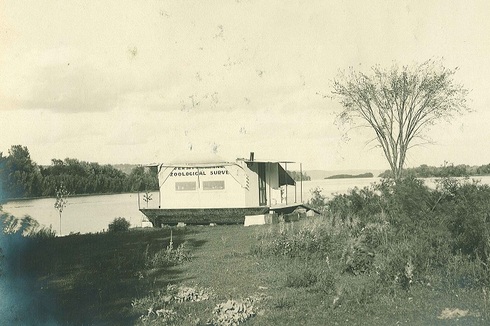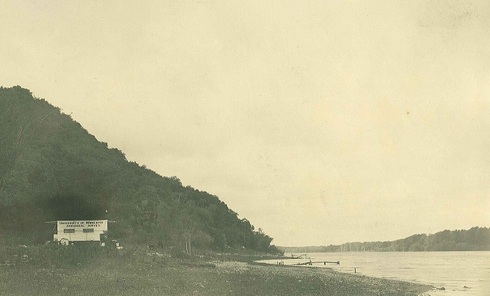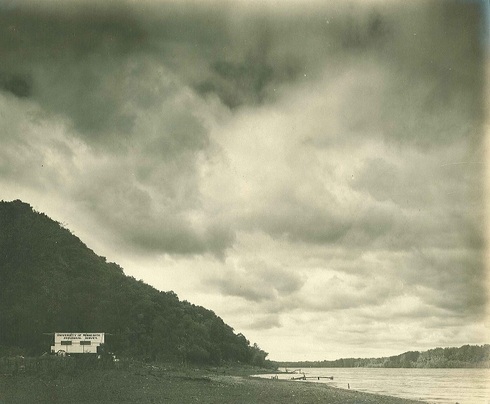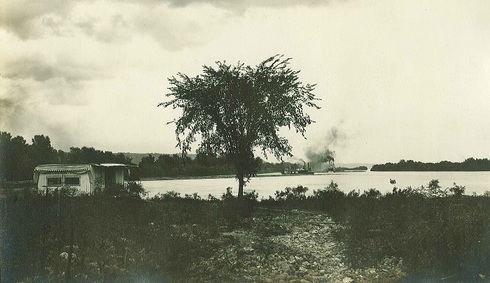Well, the time has come, June is here! This means that the Exploring Minnesota’s Natural History grant project has come to an end. The final metadata has been sent to the University Libraries web developers, and the digitized materials from 13 natural history related collections preserved at the University Archives will slowly begin to trickle in to the UMedia Archive.
After a year since the Exploring blog launched, with over 200 entries posted, we would be remiss if we didn’t share a few last important glimpses into the collections. First and foremost, the story of the Megalops must be told…
From “The ‘Megalops’,” by Henry F. Nachtrieb, Minnesota Magazine, 1899, pg. 18
“House boats are common things on the Mississippi River from Saint Paul down to New Orleans. Many are plain and simple, while a few are quite elaborate and very attractive. The best of them, however, never drew forth so much interest, questioning and varied comment as the little white, ‘Megalops…'” :
Ulysses Cox, of the Mankato Normal School, reported in the publication of the Annual Meeting of the Indiana Academy of Sciences his recollection of being called to Minneapolis by Professor Henry Nachtrieb, the Director of the Minnesota Zoological Survey, to devise a strategy to conduct further study of fish and other aquatic fauna of the state. Specifically, Nachtrieb suggested to Cox that “a houseboat, or rather, in this case, a floating laboratory, be built at Mankato to float down the Minnesota and Mississippi rivers, at least as far as the State line.”
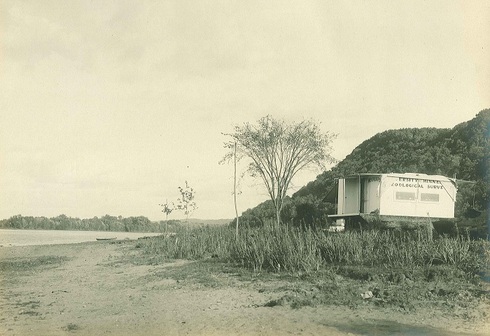
In an era when our state rivers were not frequently trafficked by non-commercial vessels, that barriers natural and man-made (sand bars, bridges) would have to be passable, and considering, “just how large the floating laboratory could be made and still float and be manageable was a question.”
Cox described the planning and construction of the boat in a paper given during the proceedings of the Indiana Academy of Sciences 15th annual meeting, 1899:
“It was finally decided to build the barge portion of the boat twelve feet wide, twenty-two feet long, two feet deep and with a flat bottom. It was estimated that a boat so built would draw, when empty, no more than five or six inches of water, which estimate proved later to be correct. On top of the barge was built a cabin twelve feet wide, fourteen feet long and six and one-half feet high. The roof of the cabin was covered with boards and then with canvas. At each end of the cabin door opened out on the platform, which was as long as the width of the boat, and four feet wide. On each side of the cabin there were two long, movable windows. In one corner of the cabin there was a well equipped darkroom for photographic work. Along the side of the room was a laboratory table fitted with drawers and shelves, and in another part were numerous shelves for specimen jars and dishes. A common cooking stove adorned one corner of the room and in the floor were two large galvanized iron tanks in which eatables were stored. Besides a complete cooking outfit, cots and bedding, we had various kinds of seines, gill nets, hooks and lines, microscopes, dissecting tools, injecting apparatus, and all other things needed for preserving any material that we might find. Besides a large number of jars and bottles, two large galvanized iron tanks served for storing preserved material.”
“We guided our boat, which we named “Megalops,” by means of two large oars that worked in oar locks placed on each end of the boat, and we found no difficulty whatever in directing the boat just where we wished, except when the wind was blowing.”
The crew of the Megalops first launched on the Minnesota River at Mankato on May 12, 1899.
Ulysses Cox to Henry F. Nachtrieb, May 8, 1899:
“Dear Mr. Nachtrieb,
We succeeded in successfully launching Megalops Saturday evening and then brought her down the river about a quarter of a mile with 25 men on board. With this load she sank into the water but about eight inches. For the first day she leaked considerable, as was expected, but now this has about stopped and I think that she will be very satisfactory. “
Cox, Nachtrieb, and crew spent four months on field investigations, moving “a mile or so and then probably stop a day or two to investigate the ground, and would remain at one place as long as the collecting was profitable.” From the Minnesota River, they navigated to Red Wing via the Mississippi River, where they concluded their trip “and did not meet with a single accident of any consequence.” The party was comprised of Professor Nachtrieb, Minnesota Zoological Survey Director, Dr. D.T. McDougal from the Bronx Park Botanical Gardens in New York City, Dr. W.S. Nickerson of the Medical School of Minnesota State University, W.S. Keinholtz, J.E. Guthrie, and Charles Zeleny, University students, George Hinton, “the ‘boy’ and ‘cookee,‘” and Cox, “who was dubbed the ‘captain.‘”
The party documented several new species of fish, which they collected and prepared for anatomical study. Cox reported, “There is no better way, it seems to me, to study the fauna and flora of a river than by such a floating laboratory, and I wish to strongly commend the plan to any persons who are considering plans for such study.”
In the spring of 1900, the Megalops departed on the Mississippi from Red Wing en route to Lake Pepin, where a large portion of investigations were conducted, before navigating along the Southern portion of the state to lay anchor for winter at Brownsville, MN. Lake Pepin proved to be an ideal location for zoological study. Cox reported, “There is water of various depths, marshes, clear pools and all the chief forms of aquatic vegetation that this region of Minnesota affords – in fact all the conditions that could be desired for an inland laboratory. The region abounds in breeding places for fishes, batrachians and reptiles; many species of mollusks are found in the lake, and the lower forms of aquatic life are everywhere abundant.”
Those interested in the construction of the Megalops and its travels can consult the correspondence in the Henry Francis Nachtrieb papers, circa 1899-1900.
Exploring will post a proper goodbye at the end of this week…
